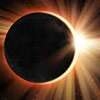A rare hybrid solar eclipse on April 20

A rare hybrid solar eclipse will take place on April 20, Chairman Arthur C Clarke Center for Modern Technologies, Professor Chandana Jayaratne said.
"It is known as a hybrid eclipse because it will shift from a total eclipse to an annular solar eclipse as the moon's shadow moves over Earth. For some locations in the solar eclipse's path on the world, viewers will witness a total solar eclipse, whereas in other parts, they'll witness a ring-like annular solar eclipse. In both cases, the moon will pass between the Earth and the sun, blocking out all or most of the sun's light falling on the Earth's surface" he said.
"Since the Moon's orbit around the Earth is elliptical the Moon's distance from the Earth can vary by about 6% from its average value. Therefore, the Moon's apparent size varies with its distance from the Earth, and it is this effect that leads to the transition between total and annular eclipses" Professor Jayaratne said in a statement.
He said that unfortunately, this eclipse is not visible to Sri Lanka as well as many parts of the world and added however, the eclipse is visible for a few regions in Western Australia, East Timor, and the eastern Indonesian islands, and viewers in those countries can get ready to see the show of a lifetime.
The eclipse will be visible only to 8.77% of the world’s population. In Sri Lanka Standard Time, the eclipse will begin in the Indian Ocean at 7.04 a.m. and end at 12.29 p.m. over the Pacific Ocean on April 20, according to Professor Jayaratne.
" There are just two locations on Earth that will be able to witness the eclipse transition from annular to total before transitioning back to annular again. However, these locations are unfortunately in the middle of the ocean.
Hybrid eclipses are very rare. The last hybrid eclipse occurred nearly 10 years ago, on Nov. 3, 2013, and the next hybrid solar eclipse will occur in November 2031.
Though this eclipse is not visible to Sri Lanka, it can be observed live through several websites he said.
